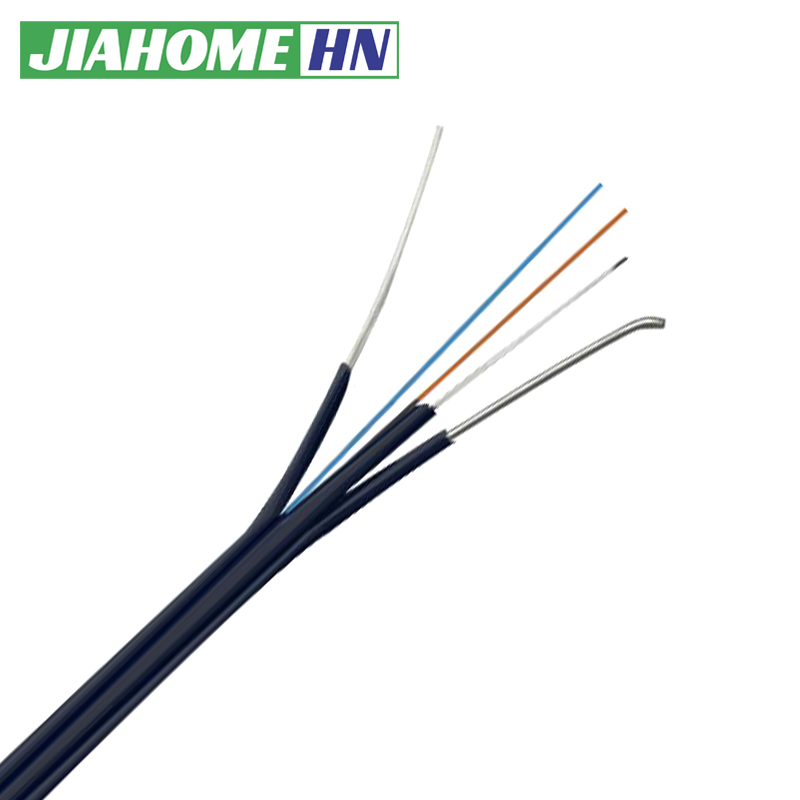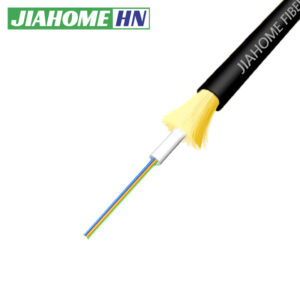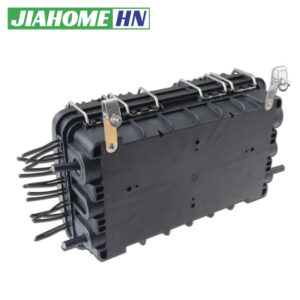FTTH Drop Cable 1 Core Outdoor-GYJXCH
APPLICATION:
● Internal FTTH applications horizontal and riser.
● Clipping to surfaces including skirting boards.
● Fiber to the home
Warranty :20years
Delivery time:2week/container
Production capacity:50000km/month
Package:Strong axis coil 2km 1km
Carton:OEM and strong 5-7Layer carton
Standards:IEC60794 ISO9001
Diameter:2x5mm
描述
FTTH drop cable is designed to be flexible, durable, and easy to install, ensuring efficient fiber deployment to homes and buildings. The typical GJYXCH self-supporting butterfly drop optical cable consist of Solid messenger wire 1.0mm/1.2mm steel wire ,and 2pcs of Stronger steel wire as Strength member ,Extrude with outer sheath lszh (low smoke zero halogen) suitable for outdoor indoor used.
Technical data sheet:
| Part code | FTTH-SXX-XXF | ||||
| Number of Fibers | Unit | 1 | 2 | 4 | 8 |
| Strength member | Material | FRP
0.5mm |
FRP 0.5mm | FRP
0.5mm |
FRP
0.5mm |
| Messenger wire | Material | Solid Phosphate steel wire 1.0mm | |||
| Outer sheath | Material | Lszh
black |
Lszh black | Lszh
black |
Lszh black |
| Cable nominal Diameter | MM ±0.1 | 2.0*5.1 | 2.0*5.1 | 2.1*5.1 | 2.1*5.6 |
| Cable nominal weight | Kg/Km ±2 | 21 | 21 | 21 | 21 |
| Max. working tension
|
N | 600 | 600 | 600 | 600 |
| Span | Meter | 50-60 | |||
| Max. crush resistance | N | 600 (Short term) / 400(Long term) | |||
| Min. bending radius | At full load 20 x Cable OD (including poles)
At no load 15 x Cable OD |
||||
| Temperature range | Installation -0 -> +50 Operation -20 -> +70 | ||||
Types of FTTH Drop Cable:
Flat Drop Cable:
Construction:Typically has a flat design with two strength members on either side of the optical fibers, providing good tensile strength.
Advantages: Easy to install, lightweight, and commonly used for aerial installations.
Application: Ideal for both aerial and conduit installations due to its compact and flexible design.
Round Drop Cable:
Construction: Cylindrical shape with optical fibers and strength members in the center, typically surrounded by a protective outer sheath.
Advantages: Offers better mechanical protection and tensile strength than flat cables.
Application: Used in both indoor and outdoor environments, including conduit, duct, or direct burial installations.
Self-Supporting Drop Cable (Figure-8 Cable):
Construction: Features a messenger wire (often steel) that is integrated into the cable, forming a “figure-8” shape.
Advantages: Eliminates the need for a separate support wire in aerial installations.
Application: Ideal for long-span aerial deployments as it reduces installation costs and simplifies the process.
Indoor/Outdoor Drop Cable
Construction: Designed for both indoor and outdoor use, these cables typically have a robust outer sheath for environmental protection and an inner fire-retardant jacket for indoor safety.
Advantages: Provides flexibility by allowing installation from the street to inside the premises without needing to change cables.
Application: Perfect for scenarios where the cable transitions from outdoor to indoor spaces.
Armored Drop Cable
Construction: Includes an additional protective layer, typically steel armor, that surrounds the optical fibers.
Advantages: Provides excellent protection against rodents, physical damage, and harsh environments.
Application: Suitable for underground or direct burial installations in areas where extra protection is needed.
Pre-terminated Drop Cable
Construction: Comes with pre-installed connectors (such as SC/APC, SC/UPC) on one or both ends.
Advantages: Reduces installation time and cost by eliminating the need for field termination and splicing.
Application: Ideal for residential or office buildings where quick installation is required.



-dd.jpg)



